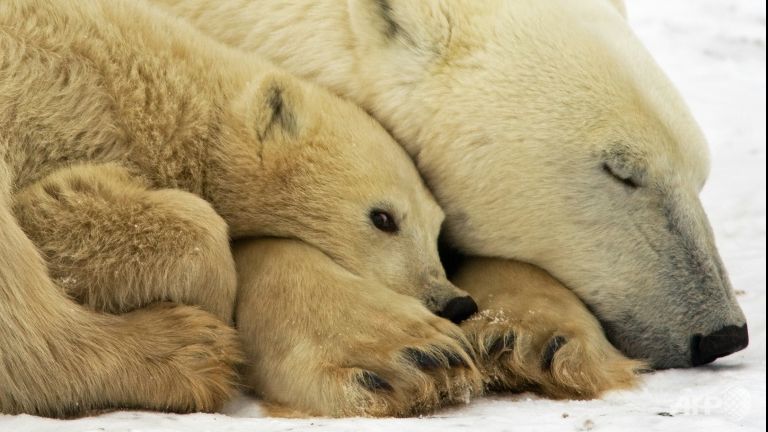Climate change could slash polar bear numbers 30% by 2050
 |
| Reproductive failure and starvation are among the dangers that follow from a warming climate. (Photo: AFP/Paul J. Richards) |
GENEVA, Switzerland: Polar bears look set to see their numbers dwindle by nearly a third by mid-century, a top conservation body said Thursday, warning climate change poses the greatest threat to the king of the Arctic.
The International Union for the Conservation of Nature (IUCN) said a reassessment of the status of the polar bear in its famous Red List of threatened species confirmed the giant mammal's status as "vulnerable".
IUCN said there were currently between 22,000 and 31,000 polar bears globally, but warned their numbers were likely to shrink fast, with the rapid loss of their sea ice habitat due to global warming posing the greatest threat to their existence.
"We're expecting more than a 30-percent loss over the coming 35-40 years," Dena Cator of IUCN's Species Survival Commission told AFP.
The travails of polar bears, which no longer have as many floating ocean perches from which to hunt seals, has been well documented.
 |
REPRODUCTIVE FAILURE, STARVATION
IUCN pointed out in a statement that if any more than five months out of the year are ice-free, the bears are forced to fast for longer, "which is likely to lead to increased reproductive failure and starvation in some areas."
This is alarming, as recent studies show Arctic sea ice is shrinking faster than most climate models had predicted.
Some parts of the Arctic are now expected to cross the five-month-ice-free threshold by the middle of the century, IUCN said.
"Based on the latest, most robust science, this assessment provides evidence that climate change will continue to seriously threaten polar bear survival in the future," IUCN chief Inger Andersen said in the statement.
Warming Arctic temperatures could also reduce the habitat and increase the chances of disease among the species polar bears prey on, including ice seals, it warned.
Climate change is also increasing other threats against polar bears.
The retreat of the polar ice cap has opened up sea routes through the Arctic and has allowed more resource exploration, thus increasing pollution.
IUCN warned that especially oil development in the region poses numerous threats, ranging from oil spills to increased human-bear interaction.
The polar bear is not the only species in trouble.
IUCN's updated Red List covers 79,837 assessed species, of which 23,250 are threatened with extinction.
A full 24 species were newly assessed as critically endangered and possibly extinct, the conservationist group warned.
Eleven orchid species found only in Madagascar, as well as the Haha, a plant native to the Hawaiian island of Kauai, and not seen since 1998, were on the list, IUCN said.
The Arico water frog, which had been threatened in its native habitat in Chile by water extraction for human use and cattle ranching, has also been placed on the list, since it had not been seen since 1976, it said.
What the stars mean:
★ Poor ★ ★ Promising ★★★ Good ★★★★ Very good ★★★★★ Exceptional
Latest News
More News
- 72 nations sign landmark Hanoi cybercrime convention (October 26, 2025 | 18:00)
- UN Secretary-General commends Vietnam’s global leadership (October 26, 2025 | 09:00)
- APEC finance ministers convene to tackle regional challenges (October 22, 2025 | 17:31)
- Rewiring global trade: ASEAN’s rise as supply chain hub (October 17, 2025 | 11:40)
- Vietnam attends first World Nuclear Week Forum in Russia (September 26, 2025 | 10:50)
- Vietnam attends 69th session of IAEA General Conference (September 16, 2025 | 10:00)
- ADB, WB pledge over 12 billion USD for ASEAN power grid, renewable energy projects (August 15, 2025 | 14:18)
- Lowy Institute proposes AI-based tobacco control solutions for ASEAN (August 15, 2025 | 14:14)
- Cloud computing policy to position Malaysia as regional hub by 2030 (August 15, 2025 | 14:11)
- Thailand, Cambodia suffer numerous cyber attacks (August 05, 2025 | 16:19)


















 Mobile Version
Mobile Version